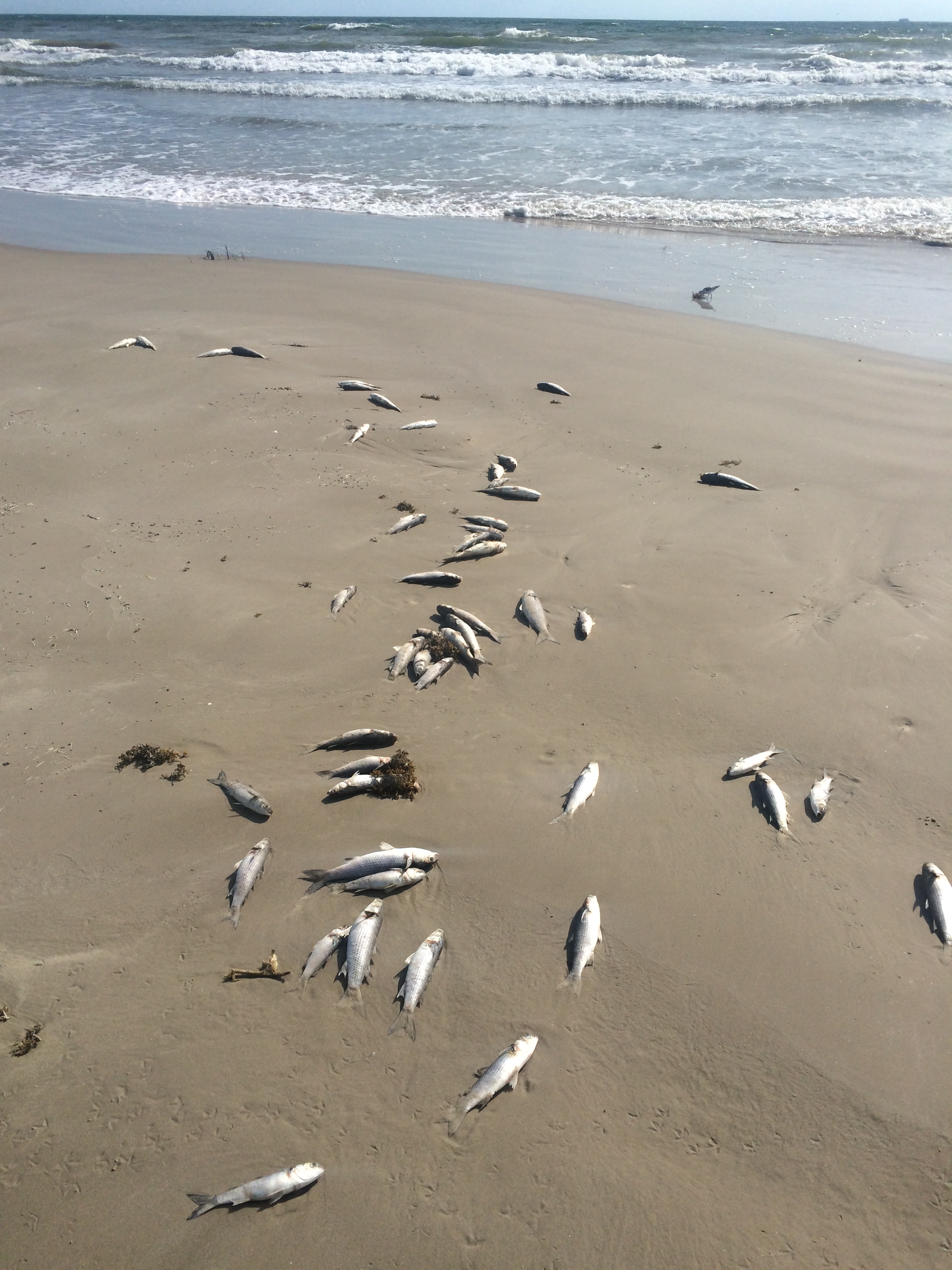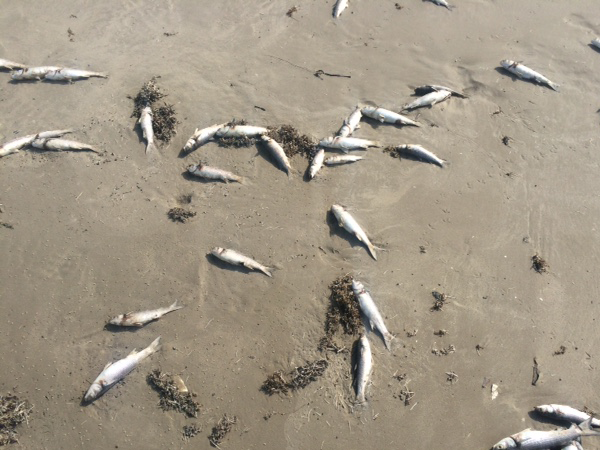 The fish kill, found today, at the north jetty is likely caused by red tide. Credit: Tony Amos.University of Texas Marine Science Institute (UTMSI) scientists confirmed that samples from two different locations (Fish Pass and Port Aransas Ship Channel) had significant numbers of Karenia brevis, which is a type of microscopic alga that can cause a red tide bloom when present in high numbers. In addition, Tony Amos from UTMSI has reported a big fish kill on San Jose Island, which is likely caused by the red tide event.
The fish kill, found today, at the north jetty is likely caused by red tide. Credit: Tony Amos.University of Texas Marine Science Institute (UTMSI) scientists confirmed that samples from two different locations (Fish Pass and Port Aransas Ship Channel) had significant numbers of Karenia brevis, which is a type of microscopic alga that can cause a red tide bloom when present in high numbers. In addition, Tony Amos from UTMSI has reported a big fish kill on San Jose Island, which is likely caused by the red tide event.
Fish aren’t the only animals affected by a red tide event. It can cause problems for humans as well. The alga that is the culprit for the red tide event produce brevetoxins, which can cause irritation to your eyes, nose and throat. In addition, eating shellfish, like oysters, that have themselves ingested the Karenia brevis, can also make people sick. When the bays have high counts of this alga, the Texas Department of State Health Services will close the bays to shellfish harvesting.
When this alga is present in dense concentration they can discolor the water and the patches of water can be reddish in color. However, color is not a reliable indicator because red tides aren’t always red. Just because the water doesn’t look red, doesn’t mean that there isn’t toxicity.
Scientist Dr. Lisa Campbell from Texas A&M College Station has a unique machine that collects phytoplankton samples every 20-mintues and is a first alert warning system for harmful algal blooms, like the current red tide. This instrument is located on the UTMSI pier and is maintained by Dr. Ed Buskey’s lab at UTMSI. This Imaging Flow Cytobot is special because it automatically takes images of and classifies species of phytoplankton in real-time.
The machine is strategically placed at UTMSI's pier in the Port Aransas Ship Channel which allows it to take continuous snapshots of phytoplankton entering the Channel, which connects Corpus Christi and Aransas Bays to the Gulf of Mexico. Researchers from Texas A&M College Station and The University of Texas Marine Science Institute are currently analyzing the samples taken to get accurate cell count numbers.
The cell count numbers are provided to Texas Parks and Wildlife Department (TPWD) which has already been alerted of the red tide event. TPWD scientists are also currently taking samples to get an estimate of the magnitude and extent of the red tide event. TPWD works with Texas Department of State Health Services to help notify the public about health concerns and issue closures of fisheries, if necessary.
General facts about red tide are available at Texas Parks and Wildlife Department's website:
https://tpwd.texas.gov/landwater/water/environconcerns/hab/redtide/faq.phtml
More about the red tide research at UTMSI:
Dr. Deana Erdner’s research seeks to understand how harmful algal blooms, like red tide are regulated. Her research looks at the genetic factors and responses that control the growth and distribution of marine phytoplankton, specifically the types of phytoplankton that can cause a harmful algal bloom event.
Dr. Ed Buskey’s research seeks to understand the role of planktonic grazers in harmful algal bloom dynamics and he has several ongoing studies investigating the role of grazers in bloom dynamics of the toxic red tide dinoflagellate Karenia brevis. Dr. Buskey is the Mission-Aransas Reserve Research Coordinator, and is in charge of monitoring zooplankton at the water quality stations on a monthly bsis to detect potential changes in community dynamics. Large changes in the zooplankton community can cause harmful algal blooms, such as red tide. Dr. Buskey is partnering with scientists at Texas A&M University and Woods Hole Oceanographic Institute to measure real-time changes in zooplankton communities and detect harmful algal blooms. Early detection allows researchers to notify resource managers when levels become too high.









